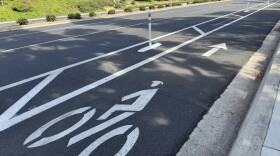Two classes of fifth graders at Spring Valley’s Rancho Elementary School were in their second day of trying out new standardized tests. They aren’t furiously filling in bubbles on a Scantron sheet. Instead, they’re all wearing ear buds to watch videos and listen to audio clips.
The test they’re taking is called the Smarter Balanced Assessment and was developed along with new voluntary national English and math standards called the Common Core.
On the Smarter Balanced website, a video about astronauts and exercise accompanies some of the sample questions. Those questions not only ask students to select one of four options that explain why the video compares being in space to lying in bed. Students are also asked to use two pieces of evidence from the video to explain in a short paragraph why it’s important for astronauts to exercise while they’re in space.
The reading passages from standardized tests of old are still there, too. But some of the new question types aren’t working on the iPads at Rancho, one of more than 2,700 schools trying out the tests in California, when Principal Wendy Newmark visited one of the testing rooms.
A question where students must drag and drop an image into the answer field was freezing some students’ screens.
But that’s the whole idea behind piloting the tests — to see what works and what doesn’t on the computers, laptops, tablets students will use to take the tests. And, from Newmark's perspective, to give educators an idea of what to prepare for.
“In the practice [math] test we gave the kids,” she said, “they would solve a problem and then explain how they got that answer in writing. So even in math there’s writing. There’s writing everywhere, which is great. That’s fantastic. We just have to make sure that they can do it.”
The Common Core focuses on students being able to explain how they arrived at an answer and why they used the strategies they did. The use of evidence from nonfiction texts to support arguments is another focus. The need to be comfortable with those demands is clear on the pilot tests.
Cara Serban-Lawler, director of technology and learning resources for the La Mesa-Spring Valley School District, went to Rancho and other schools to watch students pilot the exams she characterized as challenging.
“But the students are really focused because they’re using tools that are really relevant to them,” she said. “I think teachers and all of us are realizing that some of the instructional practices we use will need to change.”
When testing was over for the day, Serban-Lawler sat down with a couple of students to see what they thought. Ten-year-old John Pyle wasn’t interested in going back to pencil and paper.
“You got to take a test that was not really fun and take the iPad and the internet, which is fun and put it together. It’s a really good combination,” he said
Videos were another plus.
“Watching the video and listening to it with the ear phones is more easier. Then, nothing is distracting you,” Pyle said. “If you’re reading it, from eye to paper, then there’s a lot of distractions.”
Still, editing his typed responses was a challenge. Pyle said he learned about needing to proofread when part of an answer he meant to erase stayed on the screen.
“You don’t look back over, it stays there and you end up ... it just won’t make sense.”
These are the kinds of things Wendy Newmark, the principal, was watching for. She wants to make sure she helps teachers cover academic topic in a way that exercises students’ technical skills.
“Not only the typing component, but how do I put the cursor back in the middle of a word to fix something, how do I edit?” she said “Taking the time to go back and reread because there’s no spell check, learning to live life without spell check.”
This year, one classroom at Rancho has iPads full-time; other classes share a second set, which rotates rooms every two weeks.
At each school piloting the tests, Serban-Lawler noticed a difference between those two groups of students.
“Students who have had iPads in their classroom all year and who have been using them to write essays and communicate with each other and do research were much more fluent in their typing, they were faster, they looked more comfortable using the technology to take the assessment,” she said.
That difference is putting on the pressure.
“Up to this point, schools have purchased classroom sets of iPads using the funding that they have at the school sites,” Serban-Lawler said. “This assessment is creating a sense of urgency for the district to now invest some general fund dollars in providing more access, which is a good thing.”
Having an iPad for every student in two years when the new tests start to count for schools and students might be ideal. But with state funding still short of what it was five or six years ago, La Mesa-Spring Valley leaders have set their sights on a more realistic goal. They hope to have two grades of students at each school working with the devices when the tests roll out.






